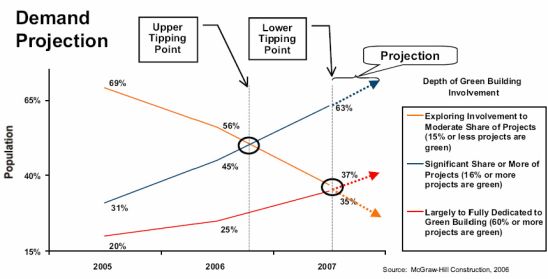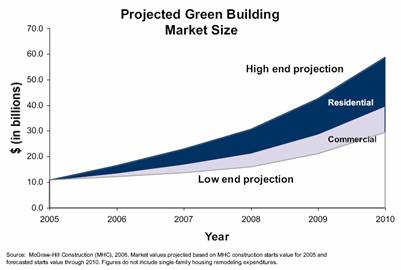The claim in a McGraw Hill NAHB report that green homebuilding will reach a tipping point in 2007 has gotten a fair amount of attention (like CNN Money and USA Today):
Green building will reach its tipping point — the point where the building community turns from “less involved” to “more involved” in the 2006 to 2007 time frame, depending on how conservative the estimate. … more than 2/3 of builders will be building green homes (more than 15% of their projects) … Looking beyond 2007, the sheer number of participants in the homebuilding market will pull the rest of the market up to their standards to remain competitive.
There’s nothing I’d like to see more than a real tipping point in green building practices. But trying to spot green tipping points often seems like the environmental community’s favorite hobby. We’re like compulsive birdwatchers looking for exotic species of environmental progress. Too often it turns out to be a wee bit more complicated than it appears at first glance.

The folks over at E: The environmental magazine dissect this tipping point a bit (sorry, sub. req.), noting that while “there’s no doubt that 2006 was a great year for green building — at least in terms of PR,” the McGraw Hill Projections may not be as “impressive as they sound.”
Early 2007, the report projects, will be a “tipping point,” in which more than 50 percent of American home builders will participate in green building. … Fifty percent of builders is not equivalent to 50 percent of houses. In 2005, only two percent of homes were built green, according to the report; by 2010, it anticipates that figure will rise between five and 10 percent. And there is still no standard for “green” building. Most such construction is self-reported. Only three percent out of those two percent of homes reported to be built green were certified green by a third party, says John Ritterpusch, director of the NAHB’s green building program. That works out to 0.06 percent of the 2005 market.

At the same time E was throwing water on these projections, several publications picked up an AP story on the sluggish rate of green building activity among large homebuilders. (USA Today ran it as “Big homebuilders say most consumers won’t pay for green homes” and Businessweek ran the more mellow headline “Big homebuilders lag on green building.”)
Green building has united disparate parties from environmental groups to big business to policymakers, but one key industry has struggled to react to the change in public sentiment. The major home builders, who account for 80% of homebuilding activity in the nation, face a unique challenge in implementing green building on a widespread scale. Many have added energy-saving features and experimented with environmentally friendly materials, but they have not yet been able to sign on a critical mass of buyers willing to pay more for them … Ara Hovnanian, CEO and president of Hovnanian Enterprises, one of the nation’s biggest home builders, says all things being equal, consumers would choose green. But all is not equal.
“Consumers have not been willing to make the investment,” he says.
So there you have it — a tipping point tips back, or perhaps wasn’t tipping as much as the tipsters said. 2007 does look like a big year for green building, but it also looks like a year in which green building’s steamroller momentum might catch a snag or two — not least increasing concern that green building deliver environmentally, and that claims of greenness by builders become more comparable.

